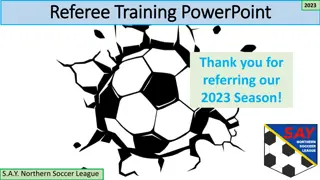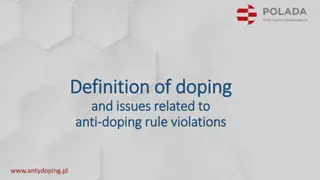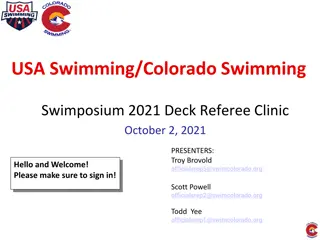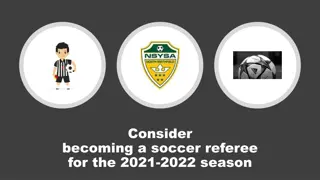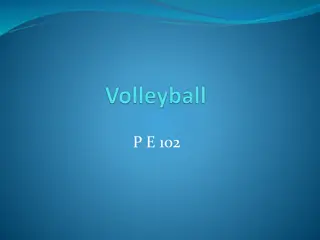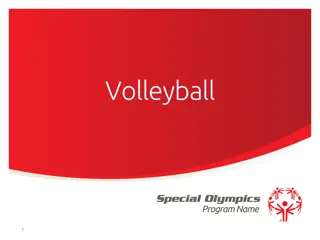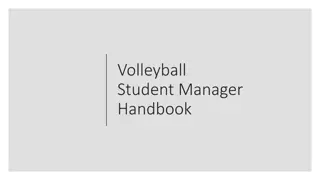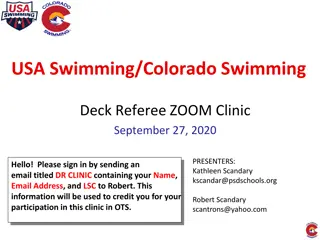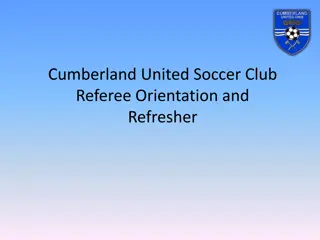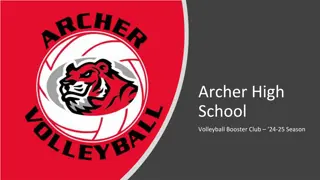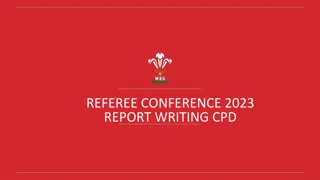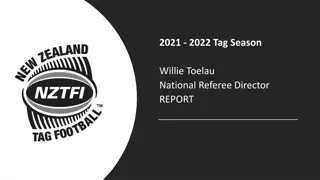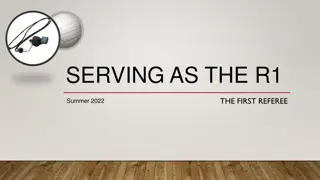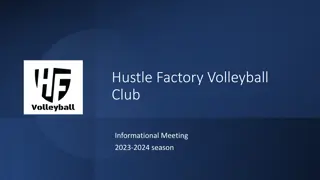Volleyball Referee Hand Signals for Common Violations
Learn the essential hand signals used by volleyball referees to indicate common violations during a game. Signals include illegal alignment, line violation, illegal hit, delay of service, over the net, net foul, legal back row attack, illegal attack of serve back row attack, and illegal block/screening. Each signal is accompanied by a detailed description and image for clear understanding.
Download Presentation

Please find below an Image/Link to download the presentation.
The content on the website is provided AS IS for your information and personal use only. It may not be sold, licensed, or shared on other websites without obtaining consent from the author. Download presentation by click this link. If you encounter any issues during the download, it is possible that the publisher has removed the file from their server.
E N D
Presentation Transcript
ILLEGAL ALIGNMENT IMPROPER SERVER Make a slow circular motion with arm and hand outstretched on the side of the violating team, palm down; then point towards the player(s) involved.
LINE VIOLATION Indicate the line where the violation occurred by extending arm and pointing toward the line with the index finger with palm facing the net. Includes foot faults, player across the center line and ball passing under the net during play (exception: a serve).
ILLEGAL HIT Slowly lift one arm and hand with the palm up on the side of the violating team, then hold the signal momentarily about chest high.
DELAY OF SERVICE Raise the hand on the server s side to a vertical position at head height with the fingers spread, palm forward.
OVER THE NET Pass forearm, palm down, over the net, originating from the side of the net where the foul occurred.
NET FOUL or NET SERVE Hold the arm outstretched on the side of the violating team lightly touching the side of the net with open hand, fingers spread and palm toward the net.
LEGAL BACK ROW ATTACK Arm on attacker s side of the net is extended parallel to the floor at chest level, palm down. Then, make one slight horizontal sweeping motion when, in the judgment of the official, it is needed to indicate a legal back-row attacker.
ILLEGAL ATTACK OF SERVE BACK ROW ATTACK Raise hand on the side of the offending team with palm forward, head high and rotate forearm forward and downward.
ILLEGAL BLOCK/SCREENING Raise both hands to head height, palms forward.
BALL TOUCHED The hand on the side of the offending team is held beside the head with the palm toward the head, then brush upward across the fingertips one time with the other hand, palm forward.
FOUR HITS The hand and arm on the side of the offending team is held high, palm forward, showing four fingers.
DOUBLE HIT The hand and arm on the side of the offending team is held head high, palm forward, showing two fingers.
BALL LANDS IN-BOUNDS Outstretched open hand, with fingers together pointing toward the center of the attack area between the center line and attack line.
OUT OF BOUNDS ANTENNA VIOLATION Raise both hands, head high, fingers together, palms toward face, elbows bent.
BEGIN SERVE Extend the arm on the serving team s side of the net, blow the whistle to begin the serve and move the extended hand and arm in a sweeping motion to the opposite shoulder.
AUTHORIZATION TO ENTER Extend the arm (palm forward) on the substitution side and make a forward sweeping motion waist high, open palm toward the respective court.
POINT Indicates point by extending the arm in the direction of the team that will serve next, palm perpendicular to the floor.
REPLAY/RE-SERVE Both hands formed into fists, thumbs up and held head high in front of the body.
SUBSTITUTION Rotate hands formed into fists, thumbs up and held head high in front of the body.
ILLEGAL SUBSTITUTION Hold arm on side of offending team head high with an open hand, fingers together. Rotate twice with elbow bent. Then indicate the court of the offending team. FOLLOWED BY SIGNAL 21a or SIGNAL 17.
TEAM TIME-OUT Place the palm of one hand horizontally over the hand on the side requesting the time-out, forming a T , then indicate the court of the team requesting the time-out by extending the vertical arm towards that court.
OFFICIALS TIME-OUT Place the palm of one hand horizontally over the hand on the side requesting the time-out, forming a T , then tap top of shoulders once with both hands.
UNNECESSARY DELAY Both hands placed on the hips with elbows straight out to the side. Then indicate the court of the offending team. Followed by signal 21a or 17.
END OF GAME Arms are crossed in front of the body, chest high with hands open, fingers together, palms toward chest then extend arms outward towards the end lines. The referees signal the game is completed and players shall move to stand on their respective end lines.
CHANGE OF COURTS Raise forearms, swinging right arm in front of the body and the left arm back of the body. Used after non- deciding games to direct teams to change courts (or after the coin toss prior to the final game if a change of courts is required).



